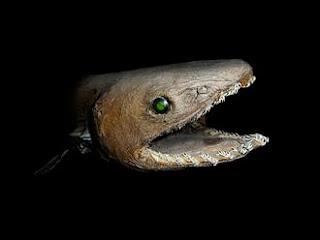
The frilled shark (Chlamydoselachus anguineus) is one of two extant species of shark in the family Chlamydoselachidae, with a wide but patchy distribution in the Atlantic and Pacific Oceans. This rare species is found over the outer continental shelf and upper continental slope, generally near the bottom, though there is evidence of substantial upward movements. It has been caught as deep as 1,570 m (5,150 ft). In Suruga Bay, Japan it is most common at depths of 50–200 m (160–660 ft). Exhibiting several "primitive" features, the frilled shark has often been termed a "living fossil". It reaches a length of 2 m (6.6 ft) and has a dark brown, eel-like body with the dorsal, pelvic, and anal fins placed far back. Its common name comes from the frilly or fringed appearance of its six pairs of gill slits, with the first pair meeting across the throat.
Seldom observed, the frilled shark may capture prey by bending its body and lunging forward like a snake. The long, extremely flexible jaws enable it to swallow prey whole, while its many rows of small, needle-like teeth make it difficult for the prey to escape. It feeds mainly on cephalopods, leavened by bony fishes and other sharks. This species is aplacental viviparous: the embryos emerge from their egg capsules inside the mother’s uterus where they survive primarily on yolk. The gestation period may be as long as three and a half years, the longest of any vertebrate. Litter sizes vary from two to fifteen, and there is no distinct breeding season. Frilled sharks are occasional bycatch in commercial fisheries but have little economic value. The International Union for Conservation of Nature (IUCN) has assessed it as Near Threatened, since even incidental catches may deplete its population given its low reproductive rate. This shark, or a supposed giant relative, is a suggested source for reports of sea serpents.
With its elongated, eel-like body and strange appearance, the frilled shark has long been likened to the mythical sea serpent. The head is broad and flattened with a short, rounded snout. The nostrils are vertical slits, separated into incurrent and excurrent openings by a leading flap of skin. The moderately large eyes are horizontally oval and lack nictitating membranes (protective third eyelids). The very long jaws are positioned terminally (at the end of the snout), as opposed to the underslung jaws of most sharks. The corners of the mouth are devoid of furrows or folds. The tooth rows are rather widely spaced, numbering 19–28 in the upper jaw and 21–29 in the lower jaw. The teeth number around 300 in all; each tooth is small, with three slender, needle-like cusps alternating with two cusplets. There are six pairs of long gill slits with a "frilly" appearance created by the extended tips of the gill filaments, giving this shark its name. The first pair of gill slits meet across the throat, forming a "collar".
The long jaws of the frilled shark are highly distensible with an extremely wide gape, allowing it to swallow whole prey over one-half its size. However, the length and articulation of its jaws means it cannot deliver as strong a bite as more conventionally built sharks. Most captured individuals are found with no or barely identifiable stomach contents, suggesting a fast digestion rate and/or long intervals between feedings. This species preys upon cephalopods, bony fishes, and smaller sharks.
The frilled shark has seldom been encountered alive, and thus poses no danger to humans (though scientists have accidentally cut themselves examining its teeth). On August 27, 2004, the first observation of this species in its natural habitat was made by the ROV Johnson Sea Link II, on the Blake Plateau off the southeastern United States. On January 21, 2007, a Japanese fisherman discovered a 1.6 m (5.2 ft) long female alive at the surface, perhaps there because of illness or weakness from the warm water. It was brought to Awashima Marine Park in Shizuoka, where it died after a few hours.
Japanese fishers regard it as a nuisance, as it damages the nets. This shark is sometimes sold for meat or processed into fishmeal, but is not economically significant. Because of its very low reproductive rate and the continuing expansion of commercial fisheries into its habitat, the International Union for Conservation of Nature (IUCN) has listed it as Near Threatened.
Wikipedia
Kathy Dowsett
kirkscubagear.com